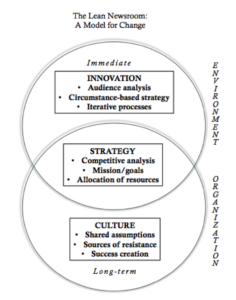Innovation.
It’s a word thrown around at lot in journalism today. There are innovation editors, teams, vice presidents, programs, and chairs at journalism schools. The New York Times produced a widely dissected internal innovation report.
At a time of massive disruption and transformation, innovation is an imperative for news organizations. But it’s also a vague notion for many journalists and newsroom leaders.
What does innovation in the context of media companies imply?
Is it innovation to try distributing your content via a new messaging app? Is it innovation to change meeting times and work habits to adapt to user behavior? Is it innovation when you launch a new feature for your community, or any new product?
The answer to all of the above can be yes. Innovation takes many forms. Above all, however, a close look at the literature and practice of innovation reveals it to be a combination of process, structure and culture. It is not one thing or product; innovation is about how your organization works and moves forward.
For the purpose of this study, innovation is defined as the process of bringing new practices, culture and products alive within an organization, to preserve core values but serve them in radically new ways.
[pulldata align=center context=”This study provides guidance and methods for implementing and inspiring innovation in your organization”]This is how people most involved in trying to help companies change think about it. “Innovation is not a person, product or an app,” said Amy Webb, a digital media futurist, whose digital strategy consultancy, Webbmedia Group, advises news organizations and other clients on innovation, near-future trends and business strategy. “A lot of the innovation that needs to happen in newsrooms has nothing to do with an app on an iPhone. A lot has to do with organization and workflow and management.”
Innovation is a process that must become ingrained in all aspects of an organization, according to journalism professors Carrie Brown and Jonathan Groves. They proposed a model of innovation for newsrooms in a 2014 paper, “The Lean Newsroom: A Manifesto for Risk,” which they are expanding into a book.
Their model draws on organizational theory, Clayton Christensen’s disruptive innovation theory, the Agile development and lean startup methodologies, and time spent with newsrooms in transition, to identify the key components of an innovative news organization. (“The Lean Startup” is a book by Eric Ries that offers a specific approach to building products and companies; Agile is a project management methodology that emphasizes adaptability and feedback loops for rapid product development.)
The below image represents Brown and Groves’ model of the many factors that come together to create an innovative newsroom. At the center of the overlapping circles are three core elements of the model: Innovation, Strategy and Culture. They are placed on a time continuum to communicate that the components of Innovation can be implemented immediately to help spur change, whereas Culture requires a long-term commitment for it to evolve and change.
In the middle of those two is Strategy, which marries aspects of Innovation (such as audience analysis) with Cultural elements to define things such as the mission and goals for the organization.
The below model also communicates the fact that that Innovation is more connected to the overall Environment in which the newsroom operates, whereas Culture is a byproduct and reflection of the organization itself.
Their model is supported by key insights offered by the 14 people interviewed for this strategy study. They lead product teams, are in charge of legacy newsrooms in transition, fund journalism innovation projects, teach and research innovation, run digitally native newsrooms, and more.
During these discussions, several key areas of innovation rose to the top, and are the focus of this study:
- Leaders must set, enforce but also nurture priorities.
- How to create a culture and structure for innovation.
- How to generate and pursue ideas.
- How to gather feedback, measure and iterate.
This study presents examples and insights in these areas, with the goal of offering actionable advice and methods to move your journalism and business forward. Some information will be of most use to traditional news organizations in transition. But overall this study should prove valuable to anyone at any type of news organization.
“In the new digital age of communications, anyone can be a media innovator,” wrote Eric Newton of the Knight Foundation in his book, “Searchlights and Sunglasses.” “Fears of the destruction of traditional media can be replaced by the excitement of creating better, more powerful journalism. If we can adopt them as fast as they come, digital tools and techniques will narrow the gap between where journalism has been and where it needs to be.”
This study provides guidance and actionable methods for implementing and inspiring innovation within your organization.
As journalist Hodding Carter III said in “Searchlights and Sunglasses”: “This is the most exciting time ever to be a journalist — if you are not in search of the past.”
Share with your network
- How to create a culture and structure for innovation
- Innovative leaders set, enforce, but also nurture priorities
- The best practices for innovation within news organizations
- How to gather feedback, measure, and iterate
- How to generate and pursue innovative ideas
You also might be interested in:
Experts define moral injury as the suffering that comes from witnessing, perpetrating or failing to prevent events that violate one’s own deeply held moral beliefs and values. It is not classified as a mental illness, but it can lead to depression, substance abuse or burnout, which is one reason news managers need to understand the phenomenon of moral injury — and ways to address it or head it off.
For many newsrooms, changing the systems that protect unhealthy culture could be a few sustained decisions away from reality.
With all of the demands on a newsroom, how do you make time to build new habits in pursuit of larger goals?



